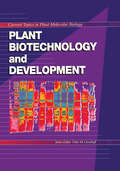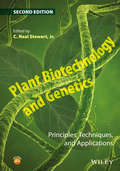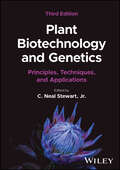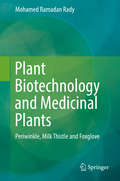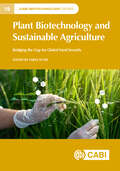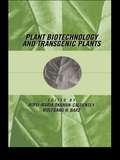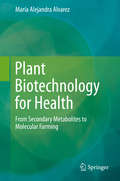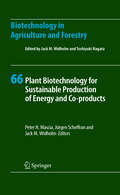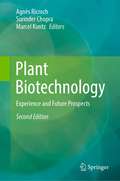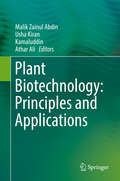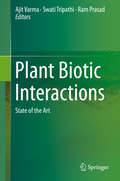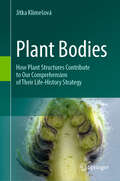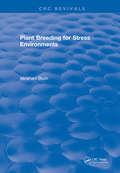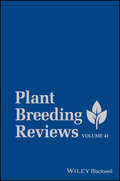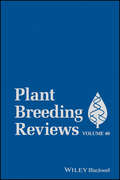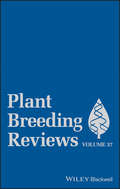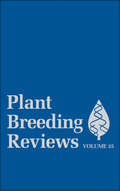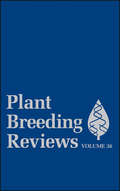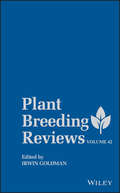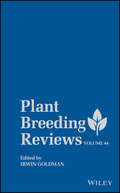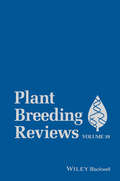- Table View
- List View
Plant Biotechnology and Development (Current Topics in Plant Molecular Biology)
by Peter M. GresshoffPlant Biotechnology and Development is the first of a series of publications designed to provide readers with an overview of current topics in plant molecular biology. Such an overview is important due to the fact that researchers from many disciplines are successfully turning their attention to plant development in an attempt to increase our understanding of the laws of nature itself. Plant molecular biology is a new field resulting from this scientific concentration and can be classified anywhere from the purely scientific to the practical and applied.Plant Biotechnology and Development addresses biochemical as well as genetic analyses, in addition to morphological and evolutionary considerations. It emphasizes plant-microbe interactions, especially legume root nodule symbiosis. A glossary of terms is included at the back of the book to enable readers new to the field to "wade" through the jargon often associated with plant molecular biology. The book is fully indexed to allow easy access to information.Plant Biotechnology and Development and the series "Current Topics in Plant Molecular Biology" will interest pharmaceutical researchers, geneticists, botanists, molecular biologists, cell biologists, biochemists, and others who would like to learn more about plant molecular biology and its influence on all disciplines.
Plant Biotechnology and Genetics
by C. Neal Stewart Jr.Designed to inform and inspire the next generation of plant biotechnologistsPlant Biotechnology and Genetics explores contemporary techniques and applications of plant biotechnology, illustrating the tremendous potential this technology has to change our world by improving the food supply. As an introductory text, its focus is on basic science and processes. It guides students from plant biology and genetics to breeding to principles and applications of plant biotechnology. Next, the text examines the critical issues of patents and intellectual property and then tackles the many controversies and consumer concerns over transgenic plants. The final chapter of the book provides an expert forecast of the future of plant biotechnology.Each chapter has been written by one or more leading practitioners in the field and then carefully edited to ensure thoroughness and consistency. The chapters are organized so that each one progressively builds upon the previous chapters. Questions set forth in each chapter help students deepen their understanding and facilitate classroom discussions.Inspirational autobiographical essays, written by pioneers and eminent scientists in the field today, are interspersed throughout the text. Authors explain how they became involved in the field and offer a personal perspective on their contributions and the future of the field. The text's accompanying CD-ROM offers full-color figures that can be used in classroom presentations with other teaching aids available online.This text is recommended for junior- and senior-level courses in plant biotechnology or plant genetics and for courses devoted to special topics at both the undergraduate and graduate levels. It is also an ideal reference for practitioners.
Plant Biotechnology and Genetics: Principles, Techniques, and Applications
by C. Neal StewartDiscover the latest edition of this authoritative textbook on plant biotechnology and genetics Plant biotechnology is a field of research and development in which scientific techniques are brought to bear on the creation and modification of new, beneficial plants and strains. Biotechnological techniques can be used to add nutritive value, increase resistance to diseases and pests, increase yields, and more. The production of biotech crops has increased over one hundred times since their introduction into commercial agriculture in 1996, making them the most rapidly-adopted crop category in the history of modern agriculture. Plant Biotechnology and Genetics is the essential introduction to this thriving research subject. Beginning with an overview of basic plant biology and genetics, it then moves to the fundamental elements of biotechnology. Now fully updated to reflect the latest research advances and technological breakthroughs, it continues to be a must-own for readers interested in the future of food production and more. Readers of the third edition of Plant Biotechnology and Genetics will also find: New chapters covering topics like genome editing, chloroplast genome engineering, and synthetic biologyUpdates throughout to incorporate increased coverage of haploid production, genomic selection, and moreSummary and discussion questions in each chapter, along with a companion website incorporating images and lecture materials Plant Biotechnology and Genetics is ideal for advanced undergraduate and masters students in plant biotechnology courses, as well as professionals seeking a helpful reference guide.
Plant Biotechnology and Medicinal Plants: Periwinkle, Milk Thistle and Foxglove
by Mohamed Ramadan RadyPlant tissue culture and advanced biotechnologies have proven to be influential tools that complement conventional breeding and accelerate development of many medicinal plants. Various approaches, such as pathway engineering, precursor feeding, transformation, elicitation with biotic and abiotic elicitors and scaling up in bioreactors, have been explored to improve the production of secondary metabolites from different medicinal plants. This book provides a comprehensive description of various studies, carried out on in vitro culture and hairy root cultures of Catharanthus roseus, Silybum marianum and Digitalis species which have been considered as alternative sources for the production of anti-tumour compounds, flavonolignans and cardenolides. Specific focus is on elicitation strategy for increasing production of bioactive compounds of C. roseus L., S. marianum and Digitalis species to overcome the constrains of conventional propagation. This book is valuable for researchers or students working on medicinal plants, phytochemistry, and plant tissue culture. It also serves as a reference for the pharmaceutical industry.
Plant Biotechnology and Sustainable Agriculture: Bridging the Gap for Global Food Security (CABI Biotechnology Series)
by Tariq AftabPlant biotechnology offers an array of powerful tools and techniques that can revolutionize the way we cultivate crops, enhance their nutritional value, and address critical challenges such as climate change, pests, and limited resources. Through understanding the genetic makeup of plants and manipulating it using scientific techniques, we can develop crops that are more resistant to pests and diseases, more tolerant of abiotic stresses such as drought and salinity, and more nutritious. Ultimately this helps us to produce more food with fewer resources and less environmental impact. As the global population continues to grow, the need for sustainable and efficient agricultural practices becomes increasingly pressing. This book describes the latest advances in genetic engineering, molecular biology, and stress physiology, and explores the ethical and regulatory considerations that underpin this transformative science.
Plant Biotechnology and Transgenic Plants
by Kirsi-Marja Oksman-Caldentey Wolfgang H. BarzContains case studies illustrating the cell culture production of pigments, flavors, and antineoplastic compounds Plant Biotechnology and Transgenic Plants covers topics that range from food to fragrances to fuel. It includes discussions of technologies and research on the engineering, synthesis, utilization, and control of primary and secondary pl
Plant Biotechnology for Health
by María Alejandra AlvarezIn this book emphasis will be put in the relevance of Plant Biotechnology for producing compounds of pharmaceutical and industrial relevance specifically the contribution of in vitro plant cell cultures for producing recombinant proteins (molecular farming) and compounds produced by plants useful for human and animal health (secondary metabolites) will be discussed. Also the description of some process held by whole plants will be included. The aim will be to provide relevant theoretical frameworks and the latest empirical research findings for professionals and researchers working in the field of Plant Biotechnology, molecular farming and biochemical engineering.
Plant Biotechnology for Sustainable Production of Energy and Co-products
by Jürgen Scheffran Jack M. Widholm Peter N. MasciaThe successful use of plant biomass for the sustainable production of energy and co-products such as chemicals is critically important for the future of humanity. Large scale exploitation of biomass is needed to decrease the production of greenhouse gases and help mitigate global warming, to provide energy security in the face of declining petroleum reserves, to improve balance of payment imbalances, and to spur local economic development. This volume discusses such uses of plant biomass as well as ways to improve the productivity and composition of plant species, including trees, perennial and annual grasses, oil-producing plants and algae, that have the potential to produce substrates such as sugar, starch, oil and cell walls, as well as energy and co-product substrates. The problems of invasiveness and gene dispersal are discussed, as are ways to mitigate these. Among the topics covered are models for integrated biorefineries to produce many co-product chemicals, the use of corn stover to power ethanol plants, life cycle analysis of biofuels, and criteria for biomass sustainability and certification. This is indeed an exciting and fast-moving time for advocates of plant biomass-based technology.
Plant Biotechnology in Ornamental Horticulture
by Yi Li Yan PeiFind out how biotechnology can produce more nutritious fruits and vegetables, more colorful flowers, and grass that needs less waterand mowing!Plant Biotechnology in Ornamental Horticulture presents an in-depth overview of the key scientific and technical advances, issues, and challenges in one of the fastest growing segments of
Plant Biotechnology: Progress in Genomic Era
by Rajarshi Kumar Gaur S. M. Paul KhuranaRefinement in sequencing technologies and potential of genomic research resulted in meteoric growth of biological information such as sequences of DNA, RNA and protein requiring databases for efficient storage, management and retrieval of the biological information. Also, computational algorithms for analysis of these colossal data became a vital aspect of biological sciences. The work aims to show the process of turning bioscience innovation into companies and products, covering the basic science, the translation of science into technology. Due to rapid developments, there seems to be no basic difference between the pharmaceutical industry and the biotechnological industry. However, approved products in the pipeline and renewed public confidence make it one of the most promising areas of economic growth in the near future. India offers a huge market for the products as well as cheap manufacturing base for export. The book is a sincere work of compilation of new and recent advances in the topic of concern through various innovative researches and scientific opinion therefrom. The book is dedicated to the readers who will definitely find it interesting and knowledgeable in carrying out their respective researches in different aspects of applied microbiology and biotechnology.
Plant Biotechnology: Experience and Future Prospects
by Agnès Ricroch Surinder Chopra Marcel KuntzWritten in easy to follow language, the book presents cutting-edge agriculturally relevant plant biotechnologies and applications in a manner that is accessible to all. This book updates and introduces the scope and method of plant biotechnologies and molecular breeding within the context of environmental analysis and assessment, a diminishing supply of productive arable land, scarce water resources and climate change. New plant breeding techniques including CRISPR-cas system are now tools to meet these challenges both in developed countries and in developing countries. Ethical issues, intellectual property rights, regulation policies in various countries related to agricultural biotechnology are examined. The rapid developments in plant biotechnology are explained to a large audience with relevant examples. New varieties of crops can be adapted to new climatic conditions in order to reduce pest-associated losses and the adverse abiotic effects
Plant Biotechnology: Principles and Applications
by Malik Zainul Abdin Usha Kiran Kamaluddin Athar AliThe book traces the roots of plant biotechnology from the basic sciences to current applications in the biological and agricultural sciences, industry, and medicine. Providing intriguing opportunities to manipulate plant genetic and metabolic systems, plant biotechnology has now become an exciting area of research. The book vividly describes the processes and methods used to genetically engineer plants for agricultural, environmental and industrial purposes, while also discussing related bioethical and biosafety issues. It also highlights important factors that are often overlooked by methodologies used to develop plants' tolerance against biotic and abiotic stresses and in the development of special foods, bio-chemicals, and pharmaceuticals. The topics discussed will be of considerable interest to both graduate and postgraduate students. Further, the book offers an ideal reference guide for teachers and researcher alike, bridging the gap between fundamental and advanced approaches.
Plant Biotechnology: The Medicinal and Phytopharmaceutical Aspects
by Durgesh Nandini Chauhan Nagendra Singh Chauhan Deependra Singh Manju Rawat SinghThis book explores our knowledge of biotechnology and its application to improving the quality of medicinal plants. With its unique and sustained focus on medicinal plant biotechnology, it offers an essential guide and a systematic reference for the development of medicinal products with the help of biotechnology from natural sources. With contributions from world-renowned experts in the fields of biotechnology, pharmaceutical biology, pharmacognosy, chemistry, and pharmaceutical biotechnology, Plant Biotechnology was written while keeping in mind the requirements of botanists, the pharmaceutical industry, biotechnologists, microbiologists, and specialists working on plant biotechnology. It can serve as either a textbook or a reference work for students, teachers, or scientists working in the field of medicinal plant biotechnology, and its readership also includes natural product chemists, biotechnologists, pharmacognosists, and pharmacologists, as well as academic and industry researchers.Features: Provides essential evidence for all specialists overseeing supportive biotechnology on its utility Discusses the fundamental techniques in biotechnology and their implementation with medicinal plants
Plant Biotic Interactions: State of the Art
by Ajit Varma Ram Prasad Swati TripathiThis book highlights recent advances in the field of plant-biotic interactions and explores current serious issues in the crop production industry. It is intended to attract more attention to these important, but often overlooked areas, and to stimulate new ideas for future research. Plants are constantly under attack by pathogens, pests, and parasites, which can significantly impact worldwide food production and human health. While pathogens and pests attack and interconnect with their hosts in a variety of ways, plants have developed sophisticated immune systems to fight infections. In the field of plant-biotic interactions, most of the studies to date have focused on the function and signaling pathways of plant disease resistance proteins and pattern recognition receptors, as well as pathogen effector proteins. In contrast, this book presents new and emerging research areas, and introduces students, researchers, academics, and policy advisors to the latest trends in e.g. microbial technology, environmental microbiology, agricultural science, the health sciences, biological sciences and other related disciplines.
Plant Bodies: How Plant Structures Contribute to Our Comprehension of Their Life-History Strategy
by Jitka KlimešováThe book presents in an accessible form how the knowledge of the shapes of the plant body contributed and contributes to the understanding of plant life strategies. It attempts to answer the questions: what are the ecological functions of plant traits such as height, shoot cyclicity or adventitious branching from roots in the daily life of a plant and/or how is the ecological function of a plant affected by its morphology and architecture. The book is the first attempt to bring together traditional botanical knowledge about plant morphology and architecture with contemporary functional ecology. In addition to the plants themselves, it also deals with those who contributed to the knowledge of the ecological function of plant forms and brings their brief medallions. The book is intended for all those who like plants, students and professional botanists.
Plant Breeding For Stress Environments
by Abraham BlumThis publication opens with the inevitable introduction, moves on to the present traditional approach to breeding for yield stability, and then enumerates a detailed discussion of the physiological approach to breeding for resistance to specific stresses. Not all environmental stresses are covered, omitting those for which little can be said today on practical breeding solutions.
Plant Breeding Reviews
by Irwin GoldmanPlant Breeding Reviews presents state-of-the-art reviews on plant genetics and the breeding of all types of crops by both traditional means and molecular methods. Many of the crops widely grown today stem from a very narrow genetic base; understanding and preserving crop genetic resources is vital to the security of food systems worldwide. The emphasis of the series is on methodology, a fundamental understanding of crop genetics, and applications to major crops.
Plant Breeding Reviews
by Jules JanickPlant Breeding Reviews presents state-of-the-art reviews on plant genetics and the breeding of all types of crops by both traditional means and molecular methods. Many of the crops widely grown today stem from a very narrow genetic base; understanding and preserving crop genetic resources is vital to the security of food systems worldwide. The emphasis of the series is on methodology, a fundamental understanding of crop genetics, and applications to major crops. The series is sponsored by the American Society for Horticultural Science and appears in the form of one or two volumes per year.
Plant Breeding Reviews (Plant Breeding Reviews #101)
by Jules JanickPlant Breeding Reviews presents state-of-the-art reviews on plant genetics and the breeding of all types of crops by both traditional means and molecular methods. Many of the crops widely grown today stem from a very narrow genetic base; understanding and preserving crop genetic resources is vital to the security of food systems worldwide. The emphasis of the series is on methodology, a fundamental understanding of crop genetics, and applications to major crops. It is a serial title that appears in the form of one or two volumes per year.
Plant Breeding Reviews (Plant Breeding Reviews #95)
by Jules JanickPlant Breeding Reviews presents state-of-the-art reviews on plant genetics and the breeding of all types of crops by both traditional means and molecular methods. Many of the crops widely grown today stem from a very narrow genetic base; understanding and preserving crop genetic resources is vital to the security of food systems worldwide. The emphasis of the series is on methodology, a fundamental understanding of crop genetics, and applications to major crops. The series is sponsored by the American Society for Horticultural Science and appears in the form of one or two volumes per year.
Plant Breeding Reviews (Plant Breeding Reviews #99)
by Jules JanickPlant Breeding Reviews presents state-of-the-art reviews on plant genetics and the breeding of all types of crops by both traditional means and molecular methods. Many of the crops widely grown today stem from a very narrow genetic base; understanding and preserving crop genetic resources is vital to the security of food systems worldwide. The emphasis of the series is on methodology, a fundamental understanding of crop genetics, and applications to major crops. It is a serial title that appears in the form of one or two volumes per year.
Plant Breeding Reviews (Plant Breeding Reviews Ser.)
by Irwin GoldmanContents 1. Maria Isabel Andrade: Sweetpotato Breeder, Technology Transfer Specialist, and Advocate 1 2. Development of Cold Climate Grapes in the Upper Midwestern U.S.: The Pioneering Work of Elmer Swenson 31 3. Candidate Genes to Extend Fleshy Fruit Shelf Life 61 4. Breeding Naked Barley for Food, Feed, and Malt 95 5. The Foundations, Continuing Evolution, and Outcomes from the Application of Intellectual Property Protection in Plant Breeding and Agriculture 121 6. The Use of Endosperm Genes for Sweet Corn Improvement: A review of developments in endosperm genes in sweet corn since the seminal publication in Plant Breeding Reviews, Volume 1, by Charles Boyer and Jack Shannon (1984) 215 7. Gender and Farmer Preferences for Varietal Traits: Evidence and Issues for Crop Improvement 243 8. Domestication, Genetics, and Genomics of the American Cranberry 279 9. Images and Descriptions of Cucurbita maxima in Western Europe in the Sixteenth and Seventeenth Centuries 317
Plant Breeding Reviews (Plant Breeding Reviews)
by Irwin GoldmanPlant Breeding Reviews presents state-of-the-art reviews on plant genetics and the breeding of all types of crops by both traditional means and molecular methods. Many of the crops widely grown today stem from a very narrow genetic base; understanding and preserving crop genetic resources is vital to the security of food systems worldwide. The emphasis of the series is on methodology, a fundamental understanding of crop genetics, and applications to major crops.
Plant Breeding Reviews (Plant Breeding Reviews)
by Irwin GoldmanPlant Breeding Reviews presents state-of-the-art reviews on plant genetics and the breeding of all types of crops by both traditional means and molecular methods. Many of the crops widely grown today stem from a very narrow genetic base; understanding and preserving crop genetic resources is vital to the security of food systems worldwide. The emphasis of the series is on methodology, a fundamental understanding of crop genetics, and applications to major crops.
Plant Breeding Reviews Volume 39
by Jules JanickCharles W. Stuber: Maize Geneticist and Pioneer of Marker-Assisted SelectionJames B. Holland, Geoffrey I. Graham, J. Paul Murphy, and M. Lynn Senior Plant Mutation Breeding: Current Progress and Future AssessmentSouleymane Bado, Brian P. Forster,Stephan Nielen, Abdelbagi M. Ali, Pierre J. L. Lagoda, Bradley J. Till, and Margit Laimer Recent Advances in Sorghum Biofortification ResearchA. Ashok Kumar, Kotla Anuradha, B. Ramaiah, Stefania Grando, H. Frederick W. Rattunde, Parminder Virk, and Wolfgang H. Pfeiffer Breeding Tropical Vegetable CornsJames L. Brewbaker and Ian Martin Maize Breeding in the United States: Views from Within MonsantoDavid V. Butruille, Fufa H. Birru, Marv L. Boerboom, Edward J. Cargill, Duane A. Davis, Prabhakar Dhungana, Gerald M. Dill, Jr. , Fenggao Dong, Agustin E. Fonseca, Brian W. Gardunia, Gregory J. Holland, Nan Hong, Paul Linnen, Thomas E. Nickson, Nalini Polavarapu, Jerald K. Pataky, Joh Popi, and Steve B. Stark The History, Development and Importance of the New Mexican Pod-Type Chile Pepper to the United States and World Food IndustryPaul W. Bosland Fruit Domestication in the Near EastShahal Abbo, Avi Gopher, and Simcha Lev-Yadun The Geneva Apple Rootstock Breeding ProgramGennaro Fazio, Terence L. Robinson, and Herb S. Aldwinckle
